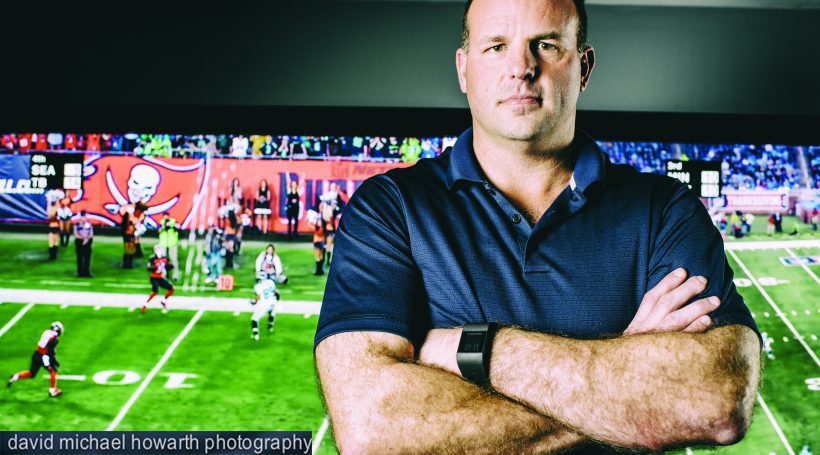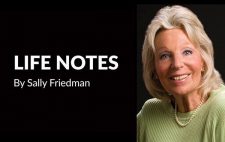Jon Runyan knows a thing or two about rules. After 14 years in the NFL – nine of them with the Eagles – and four years in Congress, he understands that consequences follow when rules are broken. It’s knowledge he relies on in his new job as the NFL’s vice president of policy and rules administration. In simple terms – he’s the guy who evaluates plays to see if a rule was broken and if a fine should be levied.
“Once I decompressed from Congress, I got back into radio, and I was on 94WIP from August to April,” says Runyan, 42. He co-hosted the station’s morning show and Eagles pre-game coverage. “When the opportunity with the NFL came, I said yes right away. I’ve always said you take the job when you don’t have to think about the decision. If you have to think about it, it’s not right for you. This was a no-brainer. Being around the game is something I’m passionate about; it’s been the vast majority of my life.”
“When I played, player safety was becoming a big issue,” Runyan says. “They keep trying to reign it in, and you learn where the limits are and you have to play on the edge of those rules. You also need to be honest and know when you’re stepping over them. That style of play and living on that edge made me different from everybody else. It was something I did that no one else was willing to do. That was a big part of what made me successful as a player, and it makes me successful now.”
Runyan and his team have a big job to do. According to the league, each NFL game averages 158 plays. With 32 teams each playing 16 games a season, that’s almost 50,000 plays over the course of a few months. Runyan doesn’t see every single one – but he gets close.
“My experience – the vast amount of football I’ve watched over the course of my life and the thousands of hours spent watching film – have prepared me for this,” he says. “We have to take a close look at the plays where we think there’s a violation – this week I think I looked at 45 plays where officials threw a flag. Some of them are no-brainers, and others I’ll rewind and watch like 50 times in slow motion.”
Runyan is looking for hard-to-see specifics, like the position of a player’s head when he makes a tackle.
“I’m watching face masks – are you turning the guy’s head to assist you in making the tackle, or did you hit your opponent in the head?” he says. “I have the advantage of stopping it, zooming in, slowing it down. I’m usually guaranteed to get video from three angles, but sometimes, depending on where the network cameras are, I get four or five. I can see, was his head up and it was legal, or did he put his head down and hit with the crown of his helmet?”
Occasionally, Runyan says, he’ll look at a play and determine that the on-field officials made the wrong call. Football is, of course, a full-contact sport. Sometimes, he says, that contact can look much more violent than it is.
“Some of them I’m like, ‘OK, they were thrown penalties on the field, but that’s how we want these guys to hit each other,’” Runyan says. “In those cases, I get why they threw the flag – it looked violent – but that’s the game of football.”
Despite his own reputation for hits and tackles that skirt the rules’ edge, Runyan says he’s not really making judgment calls so much as checking boxes.
“I don’t want to have my personal feelings involved,” he says. “For me it’s just, ‘Was it an egregious hit? Was it avoidable?’ It’s all right there in the rulebook.”
Once he’s reviewed the plays, Runyan issues fines for hits that have been deemed in violation of NFL rules. Those fines are defined by the rulebook and the players’ collective bargaining agreement with the league. Runyan says this is an important point for both players and fans who get frustrated with officials, and sometimes, with him personally.
“Part of why people get frustrated is they think we just make this stuff up,” he says. “But it’s all right there in black and white. I think part of the problem is that people – even, sometimes, the TV commentators – just don’t always understand the rules and how they’re applied. I think consistency over the long haul will fix that.” Still, players often appeal Runyan’s decision, and a hearing is called.
On an average weeknight at home, Runyan will watch two or three games at a time. Sunday night football, though, is a different story. Runyan’s son Jon Daniel is playing in his freshman season at the University of Michigan – Runyan’s alma mater – and on weeks when the Michigan team is playing at home, Runyan is in the stands.
“I go to most of JD’s games on Saturdays, so right now I’ve been traveling home on Sundays,” Runyan says. “But if we’re going to suspend somebody for something that happens Sunday, we have to do it Monday. So that’s what my team is looking for on Sundays – things that would warrant a suspension. And that’s what I’m dealing with when I’m back in South Jersey on Sunday night.”
In addition to policing tackles on the field, Runyan’s office is responsible for vetting safety equipment like helmets and shoulder pads. He’s also in charge of making sure players are adhering to the rules about their uniforms, which are stricter than many people realize.
“Earlier this season I was watching a game with some friends, and I was pointing out uniform violations,” Runyan says. “Now they all text me and say, ‘I can’t stop looking at these uniforms.’ Once it’s pointed out to you, it’s all you can look at.”
Runyan says common uniform violations are socks that aren’t pulled all the way up (“Technically,” he says, “it’s supposed to cover your entire leg from your shoe to your pants.”) and personal messages written on players’ eye-black or airbrushed onto their shoes.
“One of the bigger issues now is T-shirts hanging out the bottom of your jersey,” Runyan says. “It breaks up the continuity of the uniform. The definition of the word uniform is ‘same.’ But if you have five guys with T-shirts hanging out and six with them tucked in, it doesn’t look good.”
Runyan says uniformity is important for branding and to maintain the league’s reputation for prestige and perfection. But other uniform rules, he says, are in place for players’ protection.
“One thing we’re struggling with is tinted eye shields,” he says. “You aren’t supposed to wear one unless you’ve gotten medical approval. It can be dangerous, because if we can’t see your eyes or face and you go down after a hit, we don’t know if you’re conscious or what.”
During the upcoming offseason, Runyan hopes to make solving the eye-shield problem his pet project. He’d like to come up with a way to provide the benefits of a tinted shield while keeping players safe and officials satisfied.
In a perfect world, Runyan says, his job would not exist, though he doesn’t think he’ll be putting himself out of work anytime soon. He draws the comparison to a town that doesn’t need a police force: ideal, but unrealistic. Still, he believes the work he’s doing is vitally important to the game – not just this season, but for years and years to come.
“This is a game that has taught me a lot and given me so much from a leadership and teamwork standpoint, and, obviously, financially,” he says. “It’s something I love. I feel like a guardian of the game I love, protecting it and keeping it safe so it’s around for the next generation. It’s philosophical to say that, but I’m trying to make sure it’s being played by the rules we’ve created; to make sure it isn’t going to fall apart.”














